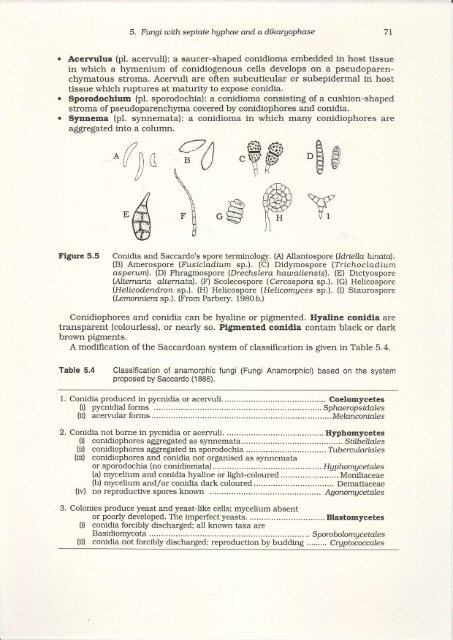Fungi with septate hyphae and a dikaryophase
Fungi with septate hyphae and a dikaryophase
Fungi with septate hyphae and a dikaryophase
Create successful ePaper yourself
Turn your PDF publications into a flip-book with our unique Google optimized e-Paper software.
5. FwWi <strong>with</strong> <strong>septate</strong> ttgphae artd a <strong>dikaryophase</strong><br />
Acenrulus (pl. acervuli): a saucer-shaped conidioma embedded in host tissue<br />
in which a hymenium of conidiogenous cells develops on a pseudoparenchymatous<br />
stroma. Acer',ruli are often subcuticular or subepidermal in host<br />
tissue which ruptures at maturity to expose conidia.<br />
Sporodochium (pl. sporodochia): a conidioma consisting of a cushion-shaped<br />
stroma of pseudoparenchyma covered by conidiophores <strong>and</strong> conidia.<br />
S5rnnema (pl. synnemata): a conidioma in which many conidiophores are<br />
aggregated into a column.<br />
"PP<br />
"()o<br />
A,..<br />
DH ffi<br />
V V<br />
"6 &<br />
-a=V o<br />
c-'/ /l<br />
B u<br />
^ v<br />
n \\<br />
\<br />
\<br />
\<br />
F. - [i<br />
lil<br />
Fi<br />
ll<br />
U<br />
Gry<br />
Ftgrrre 5.5 Conidia <strong>and</strong> Saccardo's spore terminologr. (A) Allantospore (Ifuletln tunata).<br />
(B) Amerospore (Fusicladium sp.). (C) Didymospore (Trichocladium<br />
asperum). (D) Phragmospore (Drechslera ho,waiiensis). (E) Dictyospore<br />
(Alternarin atternata). (F) Scolecospore (Cercospora sp.). (G) Helicospore<br />
(Helicodendron sp.). (H) Helicospore (HelrcomAces sp.). (D Staurospore<br />
{Lemonniera sp.). (From Parbery, 1980 b.)<br />
Conidiophores <strong>and</strong> conidia can be hyaline or pigmented. Hyaline conidia are<br />
transparent (colourless), or nearly so. Pigmented conidia contain black or dark<br />
brown pigments.<br />
A modification of the Saccardoan system of classification is given in Table 5.4.<br />
Table 5.4 Classification of anamorphic fungi (<strong>Fungi</strong> Anamorphici) based on the system<br />
proposed by Saccardo (1BBG).<br />
1. Conidia produced in pycnidia or acervuli Coelomycetes<br />
(i) pycnidial forms ..... Sphaeropsidales<br />
(D aceryular forms ..........Melanconiales<br />
2. Conidia not borne in pycnidia or acervuli ........Hyphomycetes<br />
(i) conidiophores aggregated as s5mnemata....... . StiLbeLLaIes<br />
(ii) conidiophores aggregated in sporodochia.............. ..Tuberculariales<br />
(iii) conidiophores <strong>and</strong> conidia not organised as synnemata<br />
or sporodochia (no conidiomata) ........;.. Hgptwmgcetales<br />
(a) mycelium <strong>and</strong> conidia hyaline or light-coloured ....... Moniliaceae<br />
(b) mycelium <strong>and</strong>/or conidia dark coloured........... ..... Dematiaceae<br />
(iv) no reproductive spores known Agorrcmgcetales<br />
3. Colonies produce yeast <strong>and</strong> yeast-like cells; mycelium absent<br />
or poorly developed. The imperfect yeasts. Blastomycetes<br />
(i) conidia forcibly discharged; all known taxa are<br />
Basidiomycota ........... .... Sporobolomgcetales<br />
(ii) conidia not forcibly discharged; reproduction by budding ......... cryptococcales<br />
7l






![[Compatibility Mode].pdf](https://img.yumpu.com/27318716/1/190x135/compatibility-modepdf.jpg?quality=85)










